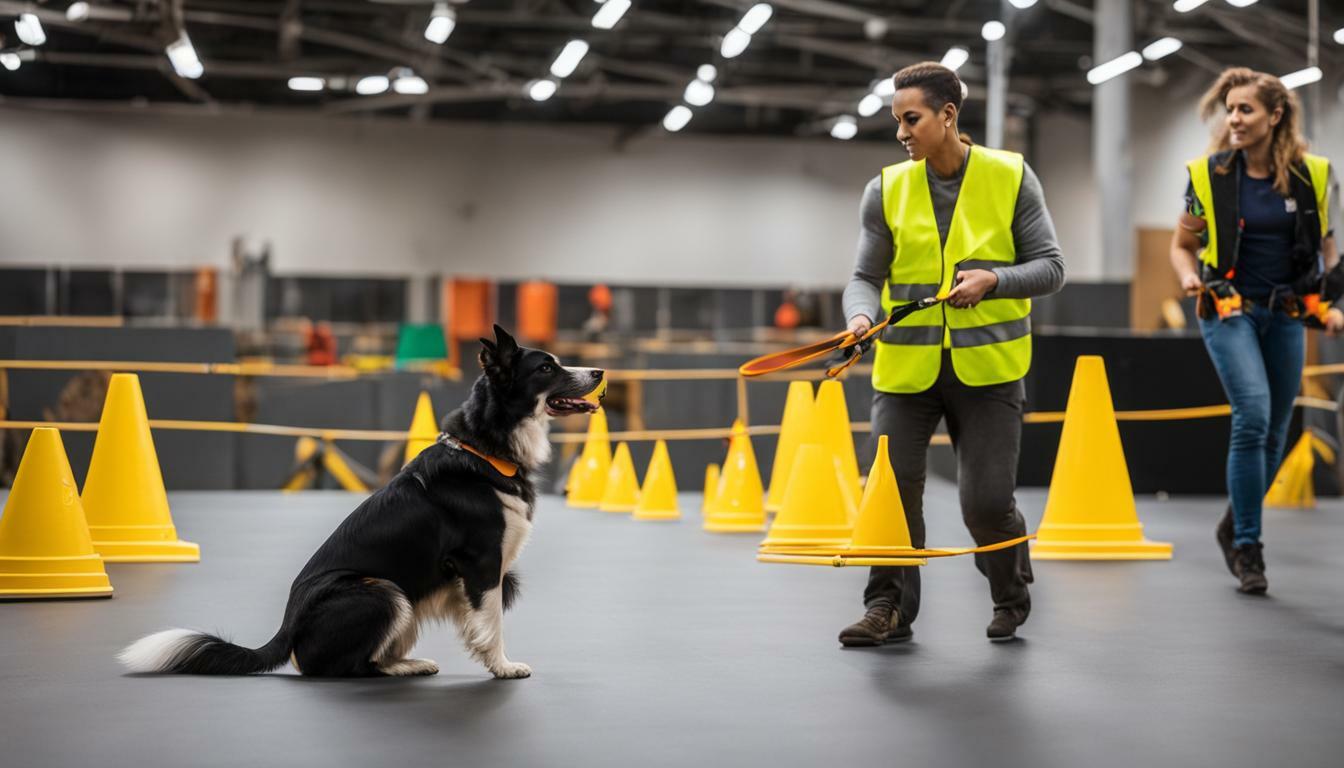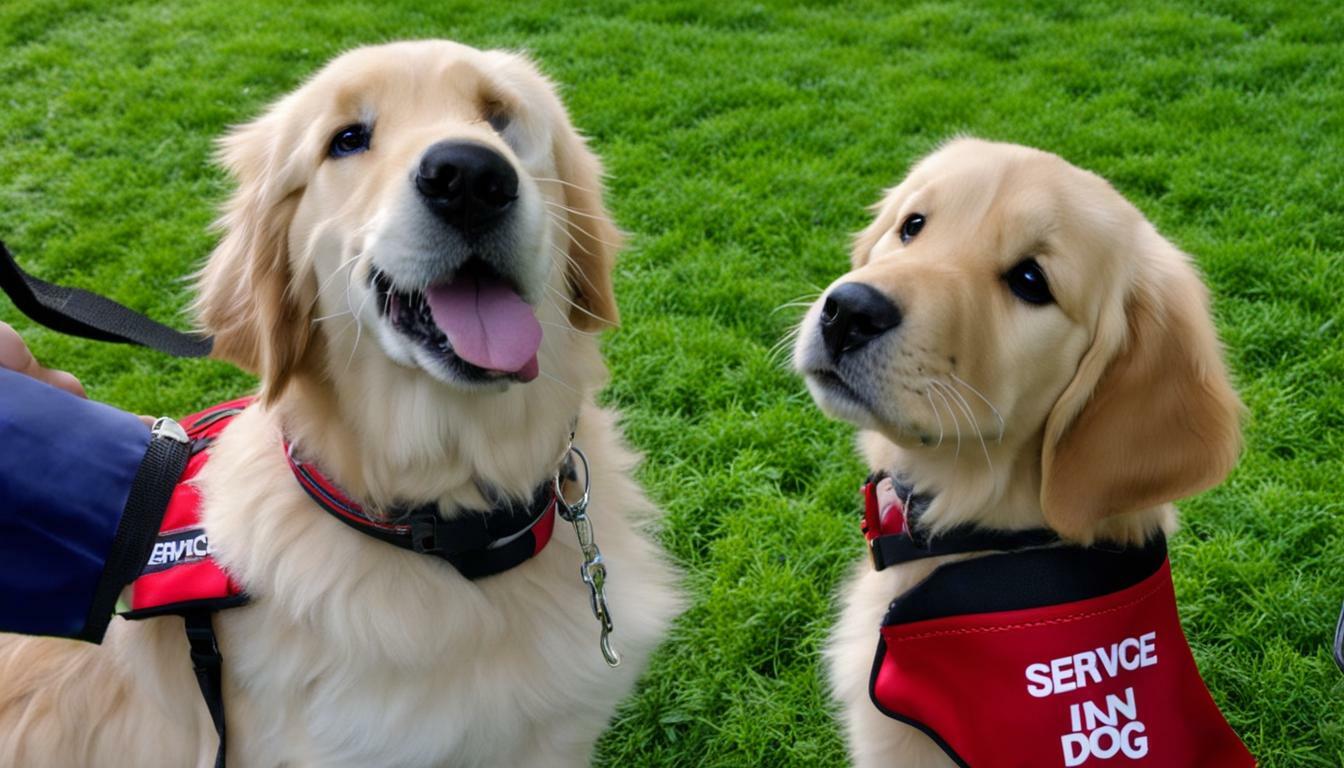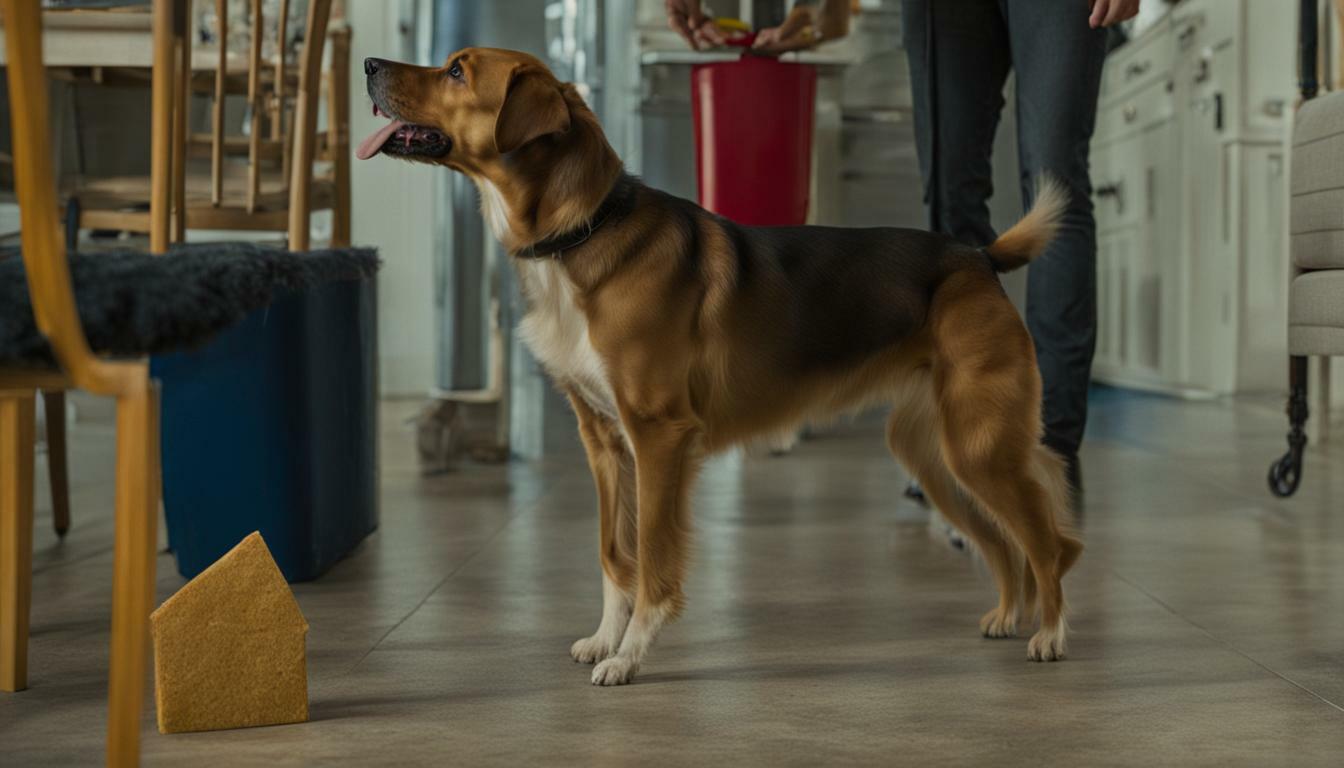If you or someone you know suffers from PTSD, you understand the profound impact it can have on daily life. Fortunately, PTSD support dogs are a valuable tool that can help alleviate symptoms, improve mental well-being, and provide a source of comfort for those affected by this condition. In this comprehensive guide, we will provide step-by-step instructions on how to train a dog to provide support for individuals with PTSD.
From assessing a dog’s suitability for training to mastering specific tasks, this guide covers everything you need to know about training your furry companion to become a PTSD support dog.
- Training a dog for PTSD support requires patience, dedication, and time.
- It’s important to understand the specific tasks and behaviors that PTSD support dogs are trained to perform.
- Not all dogs are suitable for PTSD support training, so assessing a dog’s temperament, health, and obedience is crucial before beginning.
- Establishing a foundation of basic obedience training is essential before moving on to specific tasks.
- Desensitization and counterconditioning techniques can help your dog remain calm in potentially triggering situations.
Understanding the Role of a PTSD Support Dog
Dogs have been an integral part of human society for thousands of years, providing humans with loyalty, companionship, and practical assistance. Post-Traumatic Stress Disorder (PTSD) support dogs are a specialized type of canine companions that provide additional help to individuals diagnosed with PTSD. These dogs undergo extensive training to perform specific tasks to assist their owners in managing their symptoms and improving their overall well-being.
PTSD support dogs are trained to provide emotional support, help reduce anxiety and depression, and assist with physical tasks. They are trained to perform a wide range of tasks, including alerting their owners to potential panic attacks or nightmares, creating boundaries in public spaces, and even retrieving medication. The presence of a PTSD support dog can reduce the sense of loneliness, isolation, and anxiety that many individuals with PTSD experience.
To qualify as a PTSD support dog, a dog must undergo extensive training and demonstrate a temperament that is suitable for this specialized role. The training process typically involves basic obedience training, task training, desensitization and counterconditioning techniques, public access training, and socialization exercises.
The role of a PTSD support dog is essential for individuals diagnosed with PTSD. These dogs can improve the quality of life by providing emotional support, assistance with daily tasks, and a sense of security. They can also help decrease the need for medication and hospitalization.
Individuals who use PTSD support dogs often report a significant improvement in their overall quality of life. These dogs can help their owners feel calmer, more secure, and less alone. PTSD support dogs can be an invaluable tool in helping individuals with PTSD manage their symptoms and lead fulfilling lives.

A PTSD support dog can perform many tasks to help their owner with their symptoms. These tasks can include:
- Retrieving items such as medication or water
- Alerting their owner to potential panic attacks or nightmares
- Creating boundaries in public spaces
- Interrupting unwanted behaviors or thoughts
- Providing deep pressure therapy
- Assisting with mobility and balance issues
The specific tasks a PTSD support dog performs will depend on the needs of their owner. These tasks are trained through a careful process that involves positive reinforcement and repetition.
Overall, the role of a PTSD support dog is to provide their owner with emotional support, comfort, and assistance in managing their symptoms. With the proper training and temperament, these dogs can help individuals with PTSD lead more fulfilling lives.
Assessing the Suitability of a Dog for PTSD Support Training
Not all dogs are suitable for PTSD support training. It’s crucial to choose the right dog to ensure they can learn the necessary skills and provide effective support.
When selecting a dog for PTSD support training, assessing their temperament, health, and obedience is essential. Puppies under six months old are not recommended for training as they may not be fully developed.
A calm and confident temperament is crucial for a PTSD support dog. The dog should be comfortable in social settings and not easily frightened or overwhelmed. A dog prone to anxiety, aggression, or excessive barking is not ideal for PTSD support training.
Health is also a critical factor to consider. The dog should be in overall good health, without any significant physical or medical conditions that could limit their ability to perform the necessary tasks.
Obedience training is essential for a PTSD support dog. Basic obedience such as sit, stay, come, and leash training should be mastered before moving on to specific tasks. A dog that is already well-trained will make the training process easier and more efficient.
It’s also important to assess the breed of the dog. Some breeds are better suited for PTSD support training than others. Golden Retrievers, Labrador Retrievers, and German Shepherds are popular choices due to their intelligence, trainability, and temperament.
Overall, it’s essential to choose a dog that is well-suited for the rigorous training required for PTSD support. By assessing their temperament, health, obedience, and breed, you can ensure that your dog is capable of providing effective support and enhancing your quality of life.
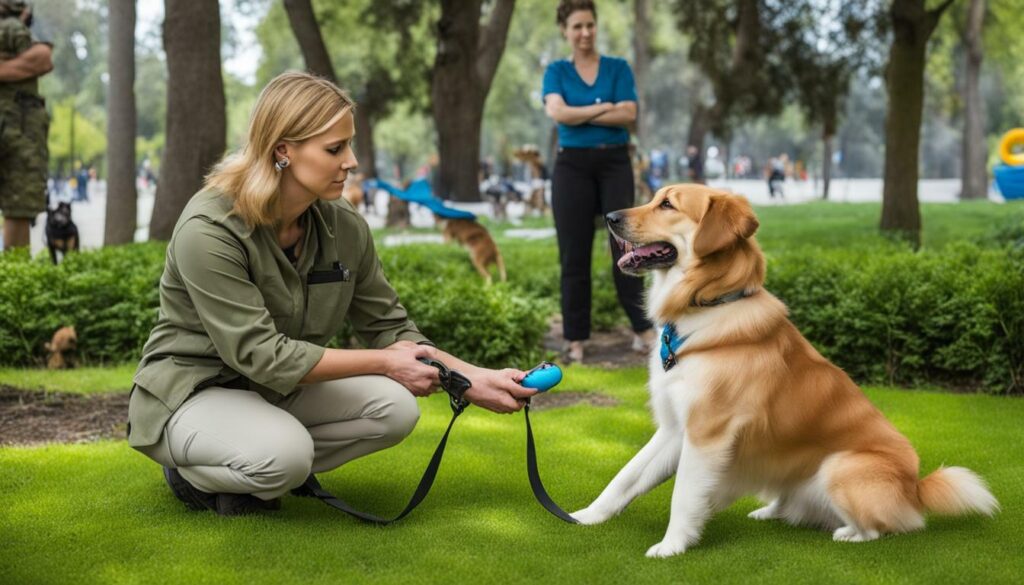
Before training your dog for specific PTSD support tasks, it’s essential to establish a foundation of basic obedience training. This foundation will help create a solid training base and strengthen the bond between you and your dog. Here are some essential commands and techniques you should teach your PTSD support dog:
| Command | Description |
|---|---|
| Sit | Teach your dog to sit on command. This command is helpful for getting your dog to remain calm and controlled in various situations. |
| Stay | The stay command teaches your dog to remain still in one place. This command is useful for situations where you need your dog to wait in a designated spot while you deal with other matters. |
| Heel | Teach your dog to walk beside you on a loose leash. This command ensures your dog doesn’t pull on the leash, allowing you to maintain control in public settings. |
| Come | The come command teaches your dog to return to you on cue. This command is essential for recalling your dog in case of an emergency or when you need to keep them close by your side. |
When training your dog for these commands, it’s essential to use positive reinforcement techniques such as treats, praise, and affection. Avoid using punishment or negative reinforcement, as this can cause fear, anxiety, and distrust in your dog.
During training, it’s essential to remain consistent, patient, and persistent. Repetition is key, and you should practice commands in various environments to ensure your dog can respond reliably in any setting. It’s also crucial to avoid distractions during training, as this can interfere with your dog’s ability to learn and respond.
In addition to basic obedience training, it’s also helpful to teach your dog good manners, such as not jumping on people or pulling on the leash. These skills will help your PTSD support dog be better equipped to handle various situations and provide optimal support.

PTSD support dogs are trained to perform specific tasks that can alleviate their owner’s symptoms and improve their quality of life. Here are some essential tasks that you can train your dog to perform:
Retrieving Medication and Other Objects
A PTSD support dog can be trained to retrieve medication or other essential items when their owner is experiencing a panic attack or other symptom. To train your dog, start by teaching them to fetch using a toy or other object. Then, gradually introduce the medication or other item and associate it with the fetch command. Over time, your dog will learn to associate the item with the command and will be able to retrieve it reliably when needed.
Creating Boundaries in Public Spaces
Public spaces can be overwhelming for individuals with PTSD, with crowds, loud noises, and unexpected movements creating anxiety and stress. A PTSD support dog can be trained to create a physical barrier between their owner and the outside world, using their body as a shield to prevent others from getting too close. To train your dog, start by teaching them to sit or stand in front of you on command. Then, gradually introduce distractions and other stimuli, rewarding your dog for maintaining their position and creating a barrier.
Providing Deep Pressure Therapy
Deep pressure therapy involves applying pressure to the body to promote relaxation and reduce anxiety. A PTSD support dog can be trained to provide deep pressure therapy by lying on top of their owner or pressing against their body. To train your dog, start by teaching them to lie down on command. Then, gradually introduce pressure by leaning against your dog or adding weight using a blanket or other object. Over time, your dog will learn to provide deep pressure therapy reliably when needed.
Interrupting Nightmares and Flashbacks
Nightmares and flashbacks are common symptoms of PTSD, often disrupting sleep and causing distress. A PTSD support dog can be trained to interrupt these episodes by nudging or licking their owner, bringing their attention back to the present moment and grounding them in reality. To train your dog, start by teaching them to nudge or lick using positive reinforcement. Then, gradually introduce the interrupt command and associate it with the behavior. Over time, your dog will learn to interrupt nightmares and flashbacks reliably when needed.
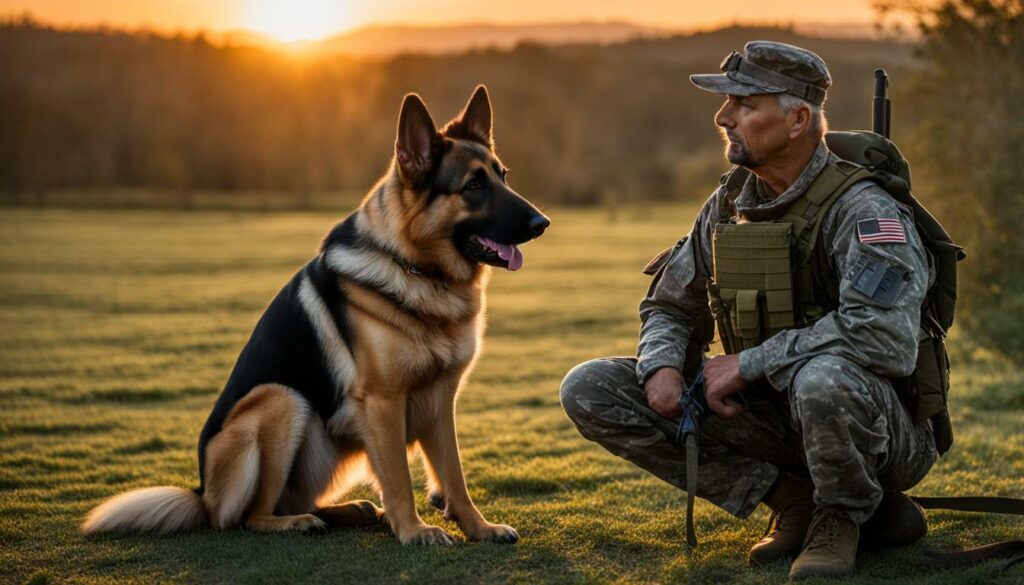
If you plan to take your PTSD support dog with you in public or stressful situations, desensitization and counterconditioning techniques are essential. These techniques help your dog remain calm and composed in potentially triggering situations, such as loud noises or crowds, enabling them to effectively support you during episodes.
The desensitization process involves gradually exposing your dog to the trigger in a controlled, safe environment while providing positive reinforcement. This helps your dog associate the trigger with positive experiences and reduces their fear and anxiety.
Counterconditioning involves changing your dog’s emotional response to the trigger by associating it with a positive experience, such as treats or playtime. This helps your dog develop a more positive association with the trigger and reduces their fear and anxiety.
It’s crucial to start desensitization and counterconditioning training early on during your dog’s training to prevent the development of unwanted behaviors or negative reactions. These techniques should be incorporated into your dog’s overall training plan and practiced regularly.
Some desensitization and counterconditioning techniques include:
- Noise desensitization: Gradually exposing your dog to loud noises, such as fireworks or thunder, while providing positive reinforcement, such as treats or playtime.
- Exposure to crowds: Gradually exposing your dog to crowded spaces while providing positive reinforcement.
- Desensitization to physical contact: Gradually exposing your dog to physical contact, such as hugs or handshakes, while providing positive reinforcement.
- Counterconditioning: Associating the trigger with positive experiences, such as treats or playtime, to help change your dog’s emotional response.
It’s essential to practice these techniques gradually, starting with small and controlled exposures, and gradually increasing the intensity and frequency over time. Consistency is key, and you should be patient and persistent throughout the training process.
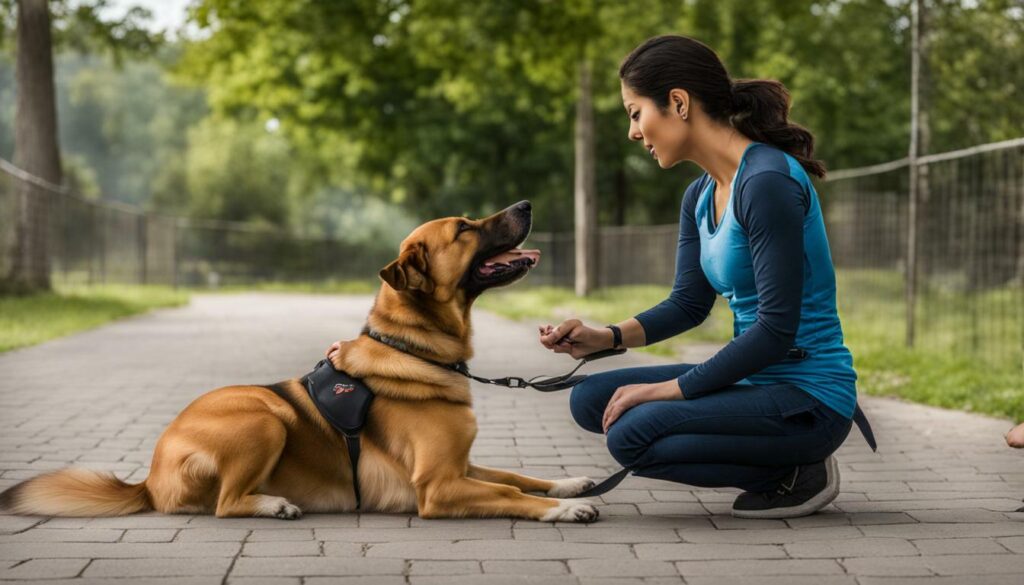
Once your PTSD support dog has completed basic obedience training and task training, it’s time to begin public access training. This type of training is essential for ensuring your dog can accompany you in public places, including restaurants, stores, and other indoor and outdoor facilities without causing a disturbance or breaking rules.
During public access training, your dog will learn how to behave politely, stay calm, and respond appropriately in different situations. This training will also help your dog become accustomed to various sounds, smells, and behaviors that may be encountered in public settings, lessening the risk of triggering episodes while in public.
One of the first steps for public access training is to ensure your dog is comfortable wearing a service vest or harness that identifies them as a PTSD support dog. This will alert others that your dog is a trained service animal and should be allowed access to public places as per the Americans with Disabilities Act (ADA).
Begin by gradually introducing your dog to different public environments, starting with less stimulating areas before moving on to busy or crowded places. Use treats and positive reinforcement to reward your dog’s good behavior and calm demeanor.
During public access training, it’s important to reinforce basic obedience commands such as “sit,” “stay,” and “heel” to ensure your dog remains under control at all times. Also, practice task training in public settings to ensure your dog can perform specific tasks correctly and comfortably in a variety of settings.
As with previous training, consistency and repetition are key to successful public access training. Regular practice and exposure to different public environments will help your dog become confident and reliable in any setting.
Remember, it’s important to be aware of and adhere to any regulations and restrictions in public settings, such as leash laws and animal restrictions. Always keep your dog under control and be mindful of their behavior to ensure they provide support without interfering with the rights and safety of others.

Once your dog has mastered basic obedience training and specific task training, it’s crucial to ensure they can behave appropriately in public settings. Public access training is an essential aspect of PTSD support dog training to ensure that your dog can accompany you to various environments.
The training guidelines for public access vary depending on the location and the type of establishment. For example, a restaurant may have different requirements than a hospital. Before starting public access training, it’s important to research and understand the guidelines in your area.
One basic requirement for public access training is that your dog must be well-behaved and obedient. It’s crucial to ensure that your dog responds reliably to all the basic obedience commands, such as sit, stay, come, and heel, in various environments and under different stimuli.
Another essential aspect of public access training is socialization. As mentioned in section 8, socialization is vital to ensure your dog can interact appropriately with people and other animals. Positive socialization experiences help your dog become well-rounded and comfortable in various social situations and environments.
The desensitization and counterconditioning techniques discussed in section 6 can also be useful in public access training. By exposing your dog to various stimuli and environments gradually, you can help them overcome fear and anxiety, ensuring they can support you effectively without causing disturbances.
It’s also worth noting that some establishments may require certification or proof of registration for your PTSD support dog to accompany you. In section 11, we’ll provide more information on the certification and legal considerations associated with PTSD support dogs.
Remember that public access training is an ongoing process, and your dog’s behavior may vary depending on the environment and stimuli. Consistent practice and reinforcement of training are crucial to ensure that your dog remains well-behaved and obedient in all public settings.
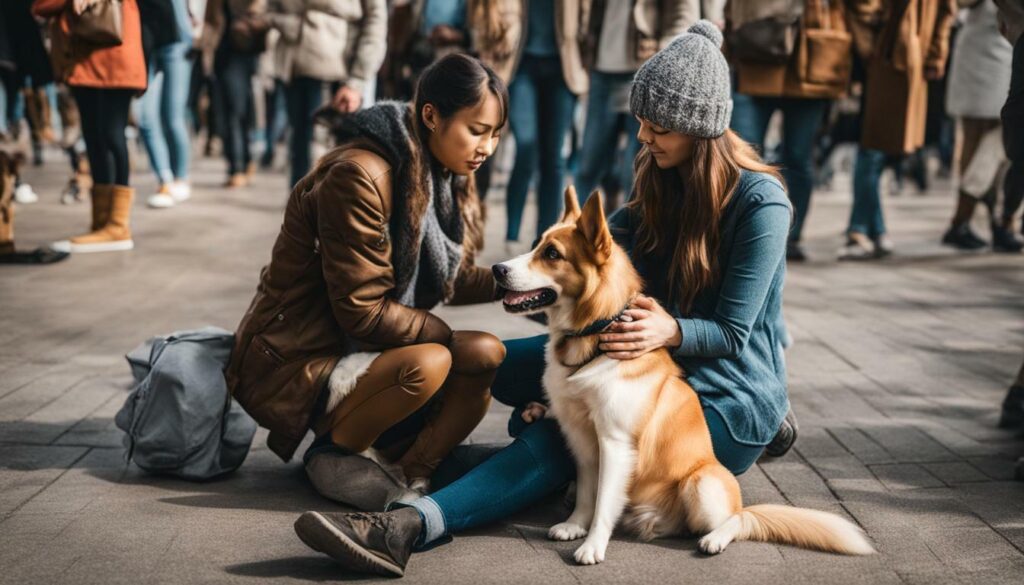
Building a strong bond with your PTSD support dog is crucial for effective communication and mutual trust. Creating a deep bond with your furry companion can help ensure their responsiveness to your needs and make them a reliable source of comfort.
One effective exercise you can try is training your dog to recognize and respond to your heartbeat. Start by lying down on your back and allowing your dog to rest on your chest. Reward your dog with treats and praise when they stay calm and relaxed in this position. Over time, your dog may begin to recognize and respond to changes in your heartbeat, alerting you to potential anxiety or panic attacks.
Another effective exercise is practicing mindfulness together. Find a quiet, distraction-free space and sit with your dog, focusing on your breathing and the present moment. This exercise can help deepen the bond between you and your dog while also promoting relaxation and stress relief.
Remember to incorporate bonding and trust-building exercises into your daily training routine to maintain a strong connection and open communication with your PTSD support dog.

Training a PTSD support dog isn’t a one-time thing; it’s an ongoing process that requires regular maintenance training. This training is essential to ensure your dog maintains their skills, behaviors, and emotional support capabilities throughout their lifetime.
Regular practice sessions will help reinforce your dog’s training, keeping them sharp and responsive to your commands. It’s also crucial to tackle any challenges or difficulties that arise promptly. This can include addressing any behavior problems or adjusting training techniques to accommodate changes in your dog’s health or abilities.
Incorporate daily practice into your routine and keep your training sessions positive and rewarding for your dog. Giving your dog plenty of love, attention, and affection will also reinforce your bond and strengthen your communication with one another.
Lastly, remember that every dog is different and may need individualized training and maintenance plans. Be patient, flexible, and consistent, and don’t hesitate to seek professional help if needed. With dedication and love, you and your PTSD support dog can maintain a strong and supportive bond for years to come.

Once your dog is fully trained for PTSD support, you may consider obtaining certification for legal recognition as a service animal. Although certification is not legally required, it can help prevent access denials and provide extra protection and benefits.
There are various organizations that offer certification options and tests, such as the American Kennel Club (AKC) Canine Good Citizen (CGC) Program, or the Public Access Test by the International Association of Assistance Dog Partners (IAADP). Be sure to research and choose a reputable organization that fits your needs and goals.
It’s important to note that while service dogs are legally protected under the Americans with Disabilities Act (ADA), emotional support animals (ESAs) are not considered service animals and are not granted the same legal rights. As a PTSD support dog owner, you have rights to access public spaces, housing accommodations, and air travel with your certified service animal, but be aware of specific regulations and requirements.
As a certified PTSD support dog owner, it’s also crucial to maintain your dog’s behavior and obedience, as any misconduct or disturbance can result in access denials or revocation of certification. Always carry proper identification and documentation with you, and be prepared to answer questions about your dog’s role and training as a PTSD support dog.
Consult with a legal professional or disability rights organization in your area for more information about the legal considerations and requirements for PTSD support dogs.

Dog training for PTSD support can be a challenging and emotional journey. Fortunately, there are numerous resources and support networks available to dog owners with PTSD. These resources can provide additional information, training programs, and a community of individuals who share similar experiences and challenges.
Organizations and Programs
Organizations such as K9s For Warriors, Paws for Purple Hearts, and Train a Dog Save a Warrior offer support and resources for veterans with PTSD looking to train their dogs for support. These programs often provide free or reduced-cost training for eligible individuals.
The American Kennel Club also offers resources and information on training service dogs for individuals with disabilities, including PTSD.
Online Communities
Online support groups and forums can provide a sense of community and a platform to connect with others who have trained their dogs for PTSD support. The PTSD Support Group on Facebook is a popular group for individuals seeking support and advice on training their dogs for PTSD support.
Therapy Dog Programs
Therapy dog programs, such as Therapy Dogs International, provide opportunities for trained dogs to visit hospitals, schools, and other institutions to provide emotional support to those in need. These programs can provide a sense of purpose and fulfillment for both the dogs and their owners.
Training a dog for PTSD support can be a difficult journey, but with the right resources and support, it can also be a rewarding experience. Don’t hesitate to reach out to these resources and communities for guidance and assistance along the way.
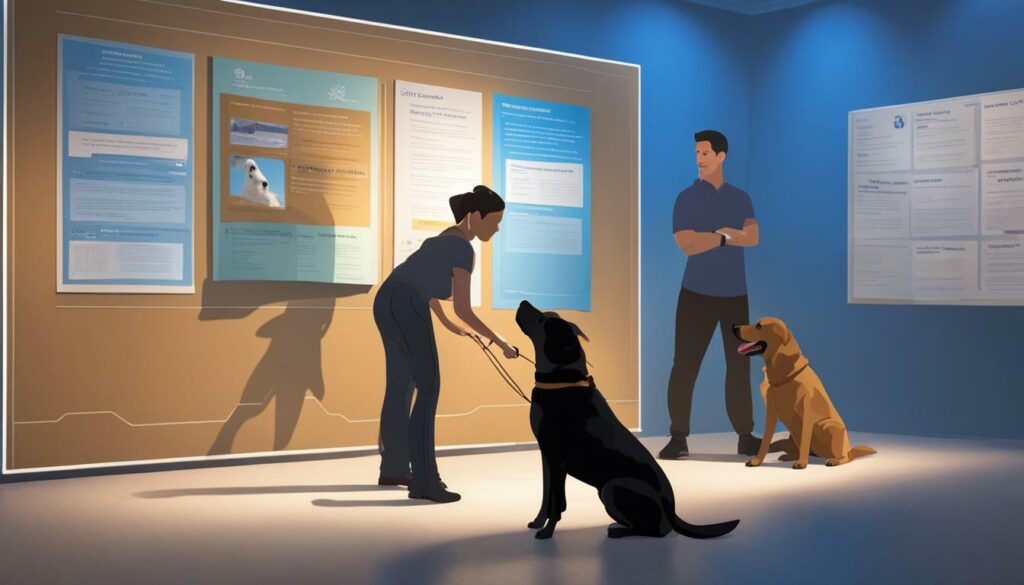
Training a PTSD support dog can pose various challenges, but with determination and patience, you can overcome them. Here are some common obstacles you may face during the training process:
- Distractions: Dogs can get easily distracted, especially in public spaces. Use positive reinforcement techniques and gradually expose your dog to different environments to build their focus and attention span.
- Time constraints: Consistency is key in dog training, but it can be a challenge to find the time to practice regularly. Incorporate training sessions into your daily routine, even if they’re short, to maintain progress.
- Setbacks: Your dog may experience setbacks in their training, such as forgetting a command or refusing to perform a task. Stay patient and positive, and reinforce previous training to help your dog regain their confidence.
If you’re facing difficulties in training your PTSD support dog, consider enlisting the help of a professional dog trainer. They can provide additional guidance and support, tailoring their techniques to your specific needs and challenges.
Remember, training a PTSD support dog can be a demanding process, but the rewards are immeasurable. You and your furry companion can form a bond that brings peace and comfort to your life, making the effort well worth it.
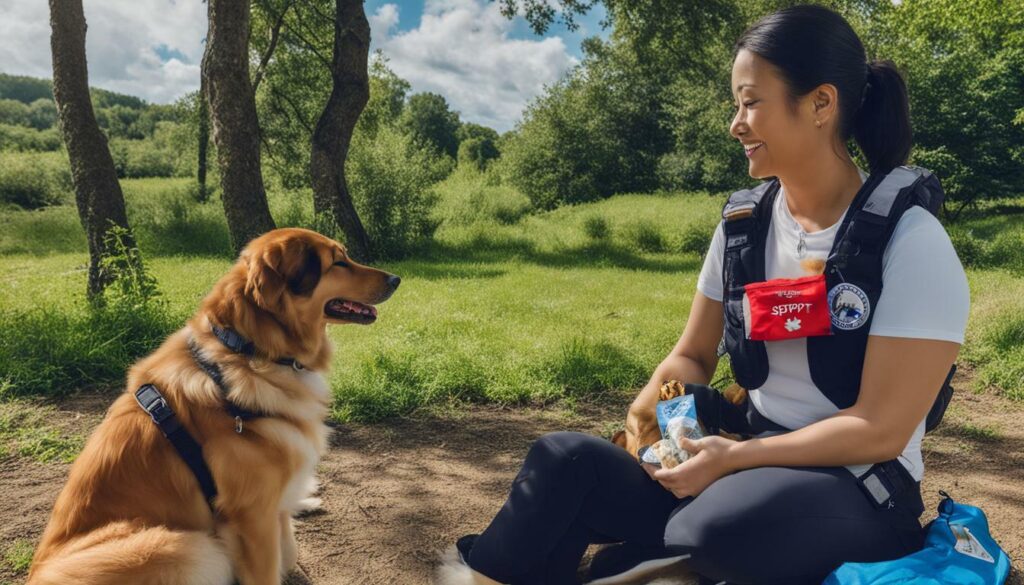
Having a well-trained PTSD support dog can have numerous benefits for individuals with PTSD. These canine companions can provide emotional support and comfort, increase independence, and improve overall quality of life. Here are some of the main benefits of having a trained PTSD support dog:
Emotional support and comfort
PTSD support dogs are trained to recognize and respond to their owner’s emotional needs. They can provide comfort and support during times of distress, anxiety, or depression. These dogs can help individuals with PTSD feel less isolated and provide them with a sense of security and safety.
Increased independence
PTSD support dogs are often trained to perform specific tasks that can increase their owner’s independence. For example, they can retrieve medication, provide balance support, or alert their owner to potential dangers. These tasks can help individuals with PTSD feel more confident and self-sufficient.
Improved quality of life
Having a well-trained PTSD support dog can make a significant difference in an individual’s overall quality of life. These dogs can help their owners manage their symptoms and cope with daily challenges. They can also provide companionship and unconditional love, which can help improve mental health and well-being.
In conclusion, training a dog for PTSD support can be a challenging process, but the benefits are worth it. A well-trained PTSD support dog can provide emotional support and comfort, increase independence, and improve overall quality of life. If you or someone you know is living with PTSD, consider the benefits of having a trained PTSD support dog.
FAQ
Understanding the Role of a PTSD Support Dog
Before diving into the training process, it’s important to understand the vital role that a PTSD support dog plays in the lives of individuals with PTSD. Learn about the specific tasks and behaviors that these dogs are trained to perform to assist their owners in managing their symptoms and improving their overall quality of life.
Assessing the Suitability of a Dog for PTSD Support Training
Not all dogs are suitable for PTSD support training. This section will guide you through the process of assessing a dog’s temperament, health, and obedience to determine their suitability for becoming a PTSD support dog. We will provide tips on selecting the right breed and individual dog for training.
Basic Obedience Training for PTSD Support Dogs
Before moving on to specific tasks, it’s crucial to establish a foundation of basic obedience training. Learn essential commands and techniques to ensure your dog can respond reliably to your instructions, creating a strong bond and a solid training base.
Task Training for PTSD Support Dogs
In this section, we will delve into the training process for specific tasks that PTSD support dogs are commonly trained to perform. From retrieving medication to creating boundaries in public spaces, discover step-by-step instructions and tips for teaching your dog the necessary skills.
Desensitization and Counterconditioning Techniques
Dogs trained for PTSD support must be able to remain calm and composed in potentially triggering situations. Learn effective desensitization and counterconditioning techniques to help your dog overcome fear and anxiety, enabling them to support you effectively during episodes.
Public Access Training for PTSD Support Dogs
Public access training is a crucial aspect of preparing your PTSD support dog to accompany you in various environments. Explore the requirements and guidelines for training your dog to be well-behaved and obedient in public settings, ensuring they can provide support without causing disturbances.
Socialization for PTSD Support Dogs
Socialization is vital to ensure your PTSD support dog can interact appropriately with people and other animals. Discover strategies and activities that promote positive socialization experiences, helping your dog become well-rounded and comfortable in various social situations.
Bonding and Trust Building Exercises
Building a strong bond with your PTSD support dog is essential for effective communication and mutual trust. Explore exercises and activities that promote bonding and deepen your connection with your furry companion.
Maintenance Training for PTSD Support Dogs
Training is an ongoing process, and regular maintenance training is crucial to ensure your dog maintains their skills and behaviors. Learn how to reinforce training, tackle challenges, and incorporate daily practice to keep your dog’s support capabilities at their best.
Certification and Legal Considerations
This section provides information on the certification and legal considerations associated with PTSD support dogs. Understand the requirements and regulations related to public access, housing, and travel, ensuring you and your dog are protected and recognized as a certified support team.
Resources and Support for Dog Owners with PTSD
Discover a list of resources, organizations, and support networks available to dog owners with PTSD. Access additional information, training programs, and connect with a community of individuals who share similar experiences and challenges.
Overcoming Challenges in PTSD Support Dog Training
Training a PTSD support dog can pose various challenges. This section provides guidance on overcoming common obstacles, managing setbacks, and troubleshooting training difficulties, ensuring you stay motivated and on track throughout the training process.
The Benefits of a Trained PTSD Support Dog
The final section highlights the numerous benefits of having a well-trained PTSD support dog. Explore how these canine companions can provide emotional support, increase independence, and improve overall quality of life for individuals with PTSD.

Marissa Delotta, 36, from Dayton, Ohio, is the creative force behind Roverboard.com, a beloved online destination for dog lovers. As a dedicated mom and canine enthusiast, Marissa combines her family experiences with her love for dogs to offer a platform where dog owners can exchange tips, heartwarming stories, and advice. Her website has become a vibrant community for sharing the joys of dog parenting. In her free time, Marissa enjoys exploring dog parks with her family and volunteering at local animal shelters.

